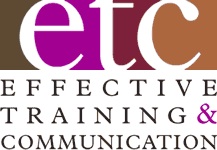You’ve had more simple questions about presentations last month … and we’ve had more simple answers.
#1. Would using speakers’ notes reduce effective eye contact?
They can but don’t have to. Notes would interfere with eye contact if you talk while looking at them or start reading them to your audience.
Remember that eye contact includes holding on someone’s eyes or face for a thought, sentence or about 8 – 10 seconds, moving IN SILENCE to another person and continuing. During that logical pause, you can glace at your notes silently, remind yourself what to say next, find a new face and continue.
The larger the font on your notes and the fewer the words, the easier it will be to quickly glance at them in silence. Therefore, you’ll be maintaining proper eye contact almost the entire time you’re actually talking.
Presenter notes are different than your detailed preparation outline. Once you’ve practiced from that outline several times, create the few presenters notes you’ll need and put your outline away. Notes are not a complete text, cue cards or a teleprompter script. They’re just notes to help keep you on track.
2. How do I use a microphone properly?
With most typical workplace presentations you’re likely to face, neither the size of the audience nor the size of the room is large enough to need voice amplification. So, simply speak up with your one-to-group energetic volume level and they can hear you fine.
On those rare occasions when you do need a microphone, don’t let the technology tail wag the presenter dog. But do make the most of the technology you have at hand:
- Where you have a choice, a wireless lavaliere is best for your maximum convenience, mobility and gesturing. Clip it high on your tie, lapel or shirt/blouse and try to bury the wire in your clothing if you can. Don’t touch the mic, as it’s very sensitive.
- If you must use a hand-held mic, again, the wireless kind is best for maximum mobility. Hold it in your non-gesturing hand below your mouth and about six inches away from it. Try to keep the mic in the same position all the time for consistent sound levels.
- If you have no alternative but a wired hand mic on the podium, keep it the same distance from your mouth. That means your physical movements will be greatly limited, so minimize this downside with even more effective gesturing.
- Check with the tech support people in the location you’ll be using to make the most of the tools you must use. If you tend to move around and the space is large, find out where the ‘hot spots’ are that can cause those annoying sounds of feedback so you can avoid them.
- Only the largest venues or events are likely to have a live technician adjusting volume in your room, so you need to establish a mic level before the audience arrives. And to avoid the lame audience question ‘Can you hear me now?’, have someone in the back of the room give you non-verbal signals about your volume.
So, make the most of your mic to help you deliver your engaging and energetic presentation.
3. How much should I practice?
Practice doesn’t make perfect. Practice only makes permanent. Only perfect practice makes perfect. That is how you get into the ‘Presenters Hall of Fame’.
- How comfortable are you with presenting in general and with the specific content in particular? The more comfortable, the less practice time is necessary to achieve your intended outcomes.
- How important is the presentation to you and the organization you represent? Said another way, what’s the cost of failing or missing the mark? The more important the presentation, the easier it should be to justify adequate practice time.
- Learn it, don’t memorize it – there’s a big difference. Memorizing your presentation will take way too long and if you forget something, you can choke and lose credibility and confidence.
Practicing your presentation effectively involves a lot more time and effort than merely looking at your outline or slides a few times before you take the platform.
Your turn – think of a few questions you might ask if you were in one of my presentation skill workshops and send them to phil@communicate-confidently.com. I’ll respond privately and might just run them in this space next month.

